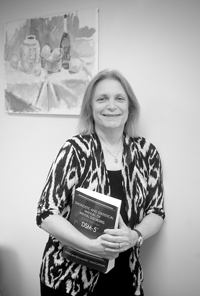Fears of children left behind under DSM-5 not materializing

Many had concerns when the fifth edition of the American Psychiatric Association’s “Diagnostic and Statistical Manual of Mental Disorders” (DSM-5) combined four separate disorders under one umbrella: autism spectrum disorder (ASD). The loss of official recognition previously given autistic disorder, Asperger’s disorder, childhood disintegrative disorder and the catch-all pervasive developmental disorder not otherwise specified triggered fears of children going undiagnosed and without services they needed.
But a year after DSM-5’s May 2013 release, those fears haven’t materialized despite conflicting research on the subject. Clinicians say they have yet to observe a decrease in the numbers of clients or referrals because of the new ASD diagnostic classification. Indeed, anecdotal evidence suggests the old names will linger.
“Some clinicians are saying ASD but using the term Asperger’s Syndrome in the narrative or what they verbally tell the family,” says Erika Drezner, MSW, coordinator of child and teen services for the Asperger’s Association of New England, based in Watertown, Mass. The association is undergoing the process of a name change to reflect DSM-5.
DSM-5 characterizes ASD by both deficits in social communication/interaction and restricted repetitive behaviors, interests and activities (RRBs). A child presenting without RRBs would end up with a diagnosis of social communication disorder instead of ASD.
In a study published online in February in the Journal of Autism and Developmental Disorders, Columbia University School of Nursing researchers found a 30 percent pooled decrease in ASD diagnosis under the DSM-5 compared to identifications previously made in DSM-IV.
But a Yale University study also published online in January in the Journal of the American Academy of Child and Adolescent Psychiatry suggests children who do not meet the new ASD standards will receive a diagnosis of social communication disorder under DSM-5. The study, which examined children aged 7-12 in a metropolitan area in South Korea, found only about 17 percent of children showed a change in diagnosis under DSM-5 criteria, three quarters of them being previously recognized as PDD-not otherwise specified.
Karen Levine, Ph.D., a developmental psychologist practicing in Lexington, Mass., says she has seen little change in diagnostic practices among colleagues over the past year, although some providers may cast a wider net than others. But as was the case with DSM-IV, there are children all practitioners would agree meet ASD diagnosis criteria and others on whom different practitioners would disagree.
“I always say children are more like snowflakes and less like DSM categories in the variety of their presentations,” Levine says.
“The longer I have been diagnosing children, and I am now in my 25th year, the more varied and nuanced they seem to me. It is perhaps easier earlier in one’s career when one may be less aware of infinite nuances. There are subjective factors even with the criteria appearing to be well spelled out, with different providers having different internal databases of children or different interpretations of degree of impairment.”
Levine notes a child’s presentation of functioning dimensions comprising ASD criteria can be influenced by factors such as anxiety, which has a high co-morbidity with ASD. That poses a challenge for clinicians who need to be mindful if the assessment scenario separates a child from parents to interact with a stranger. Reviewing video clips prepared by families of a child at home can be very useful, Levine explains.
“A child with mild social communication difficulties and significant anxiety may appear to meet ASD criteria when very anxious but not meet criteria when not anxious and hence the specifics of the diagnostic process the child undergoes can impact the diagnostic outcome,” Levine explains.
Clinicians can’t be overly focused on the label and lose sight of the individual, says Karl Wagner, Psy.D. of Powell & Wagner Associates in Westborough, Mass.
“I try to take people one case at a time here. The evaluation process is pretty extensive enough to really get to know an individual,” Wagner says. “The impact of five, I don’t know, we’ll see in three, four, or five years probably what the ramifications are. To start waving red flags about how kids are going to be more at risk or miss treatment, I think it might be a little premature to be doing that at this point.”
Danielle Wahba, M.A., LMHC, Psy.D., assessment supervisor at Community Healthlink’s Youth and Family Services in Worcester, Mass., who has a solo private practice Family Works Psychological and Assessment Services, LLC in West Boylston, Mass., says she continues to see many referrals for Asperger’s and autism.
Diagnostic labels, Wahba says, serve as justification for resources and reimbursement. “I often find that doing a comprehensive, functional assessment that focuses on recommendations and specific strengths and areas of weakness are the most important aspect in helping children and families,” she says. “I often tell families that they know their child best and their child is the same today after getting a diagnosis as they were yesterday. The unique needs of the child are paramount. Just as Individual Education Plans should be structured to the individual child rather than the diagnosis or disability, so should the assessment and treatment planning.”
